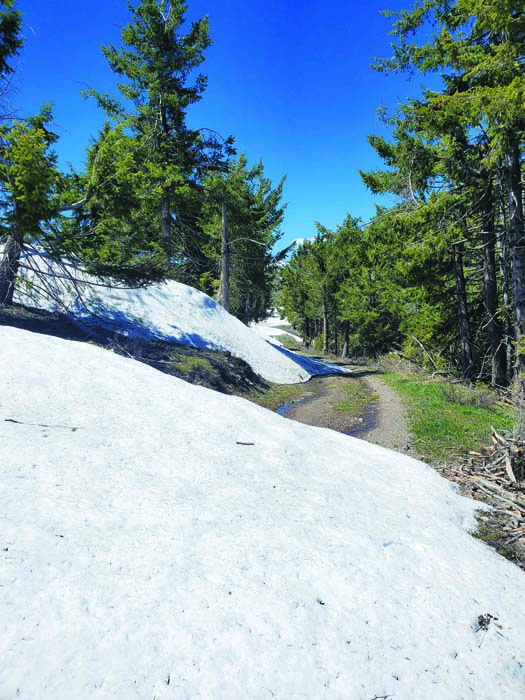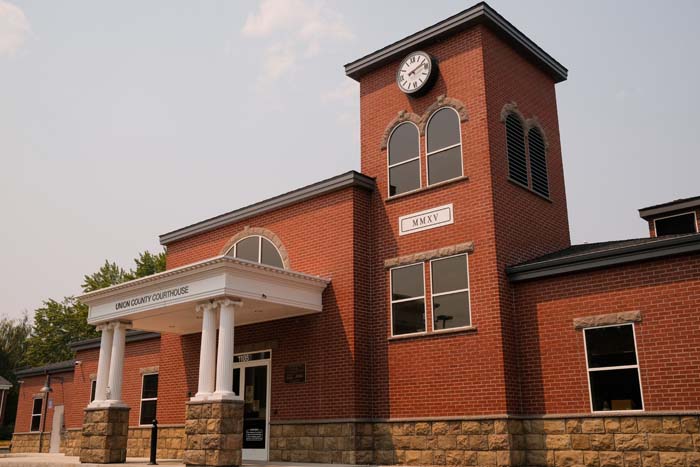Out and About: The snowdrifts (and a bear) of Skyline Road
Published 10:57 am Friday, May 17, 2024

- A series of snowdrifts forms each winter along the Skyline Road, about 15 miles south of Baker City, and they typically linger until around Memorial Day.
On the hottest day of the year I went to have a look at my favorite snowdrifts.
Trending
I ended up tracking a bear.
Actually that’s overstating things a bit.
I saw a bear.
Trending
And I examined its tracks across one of the aforementioned drifts.
But I had no inclination to follow the bruin into the forest.
My wife, Lisa, and I have been on quite a run recently as bear sightings go.
Neither of us could remember the last time we had seen one but we agreed that several years, and likely a decade or more, had passed.
Then, within the span of a week, we saw four, in two separate sightings.
The first happened on May 5, a Sunday. We were driving home from near Anthony Lakes. As we rounded the long curve near the junction with the Anthony Creek Road, a sow and her two cubs, a pair of black puffballs that looked to me about the size of Lab puppies, waddled across the highway.
That was a chilly day. Several inches of snow had fallen earlier in the weekend, and a brisk northwest wind propelled a few flurries as Lisa and I snowshoed near the granite quarry east of Floodwater Flats.
But then spring, that great conniver, rapidly swapped winter for summer.
On Mother’s Day, with the temperature forecast to rise into the 80s for the second straight day, Lisa and I drove to Dooley Mountain Summit, about 15 miles south of Baker City.
Our real destination, though, was the crest of the ridge that forms the divide between the Powder River to the north and the Burnt River to the south.
This is among my favorite spots during May.
The south slopes are never so lush, a natural garden of dark green bunchgrass, gray sage and a wildflower spectacle highlighted by pink and purple phlox, buttercups, prairie stars, bluebells and, depending on the year, the first purple blossoms of lupine.
The views are unusually expansive even in a region where the sky sprawls.
The north panorama takes in the Elkhorns to the left and the Wallowas to the right. Turn around and the vista extends from Pedro Mountain in the east across the Burnt River high country — Monument, Bull Run and Table rocks — to Strawberry Mountain, the only summit that tops 9,000 feet between the Elkhorns and Steens Mountain.
It is a fine place for a cabin — the ultimate criterion for a viewpoint, in my estimation.
Hiking the Skyline Road also offers an intriguing lesson in the vagaries of wildfire.
The lightning-sparked Cornet/Windy Ridge fire, an inferno that eventually scorched 104,000 acres in August 2015 and was the biggest blaze in Baker County’s recorded history, swept across the Burnt/Powder Divide, charring most of the forest.
But there are clumps of trees, including ponderosa pines, Douglas-firs and grand firs, that survived.
Near the crest we paused to look at a ponderosa, two Douglas-firs and a grand fir, all within 20 feet or so of each other and all healthy. This coniferous quartet is surrounded by skeletons that, nearly a decade after the blaze, have shed much of their skin of blackened bark, which lies in piles beside their trunks.
Some of these islands of life among the charred boles don’t seem especially mysterious, even to untrained eyes like my own. Trees growing in a cleft of a north slope, a site that will remain relatively moist and cool, have an obvious advantage when flames approach.
But the scattered trees, sometimes a single specimen among hundreds of carcasses, defy an easy explanation.
But I am drawn to this place not so much by the flowers and the distant scenery and the legacy of wildfire, as by the snowdrifts.
Forest Road 11 — the Skyline Road — crosses the divide and for the next couple miles is hacked through the sedimentary spine of the divide.
This is a breezy place far more often than it is not.
During winter, the wind direction typically alternates between southeast and northwest. The roadcuts create a series of hollows, just to the north of the ridgecrest, where wind-propelled snow, which briefly loses its momentum on the leeward side, accumulates to prodigious depths.
Lisa and I have snowshoed here in mid-winter and found a polar landscape where the Skyline Road’s route, buried beneath 10 feet or more of snow, is difficult to discern.
By late spring, though, most of the snow has melted save for the remnants beside — and often on top of — the road. I have made no detailed study, but I would say that most years the road remains blocked until around Memorial Day.
I always feel the tiny thrill of anticipation as I climb the last grade before the crest, where the road switches from the south side of the divide to the north.
Every time I am fooled by the absence of snow on the exposed south slopes.
Every time I round the corner and see the white wall ahead, meltwater trickling from its base to form a short-lived stream which has no name and appears on no map.
During our Mother’s Day walk I paused there, standing on that first drift, when I saw the bear.
It, too, was standing on a drift, perhaps 50 yards to the east, toward Bald Mountain.
The animal was conspicuous not only for its inimitable ursine shape but also for the color of its fur.
Unlike the sow and cubs we saw along the Anthony Lakes Highway, this singular bear was a quite light tan, with a fringe of the color typically called cinnamon when people speak of bears.
I yelled for Lisa to look.
I also pulled my phone from the front pocket of my shorts, but before I could pinch my fingers and zoom in, the bear had rumbled into the woods below the road.
It wouldn’t have been a compelling photo anyway, as my aging Samsung has nothing like the lenses adorning the latest iPhones. I suspect that had I captured an image the bear would have been a disappointingly diminutive and indistinct blotch. It never could have replicated the dollop of adrenaline that surged when I saw the animal and recognized the species — the reaction when you come across, unexpectedly, a beast you know is almost certainly going to flee but which is eminently capable of exposing your body for the relatively fragile thing it is.
This impression was heightened when we hiked over to examine the tracks.
Bear paws leave marks unlike any other mammal common to the Blue Mountains. With their five toes, and because they sometimes overlap their front and rear paws, bears can leave tracks that somewhat resemble human feet (or, depending on your cryptozoological interests, the marks of Bigfoot).
Lisa and I chuckled as we followed the bear’s meandering route.
The bruin walked across one drift, then back to the road, over another patch of snow, onto a damp slope where the snow had only recently melted, then back onto the drift where I saw it, and where it left muddy tracks on the grainy spring snow.
We saw only the one set of tracks.
I’m no biologist but I suspect the bear was a boar. A sow in spring, like the one we saw a week earlier, is likely to be accompanied by cubs.
I felt fortunate, as I always do when I see relatively unusual wildlife.
Bears aren’t ephemeral in the way snowdrifts are in our mountains, which were sculpted by glaciers that no longer exist.
But unlike the drifts of Skyline Road, whose presence is predictable and reliable, bears are wraiths of the wild country.









